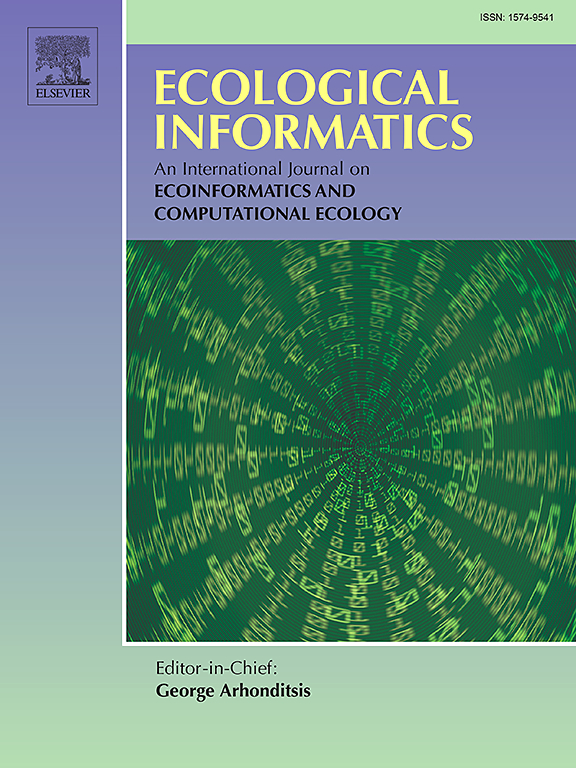Estimating chlorophyll content in tea leaves using spectral reflectance and deep learning methods
IF 7.3
2区 环境科学与生态学
Q1 ECOLOGY
引用次数: 0
Abstract
Accurate estimation of chlorophyll content in tea leaves is essential for evaluating plant health, managing fertilization, and optimizing harvest timing in precision agriculture. This study investigates the use of hyperspectral reflectance data (400–850 nm, 5 nm intervals; 91 bands) to estimate chlorophyll content in tea leaves (Camellia sinensis) using three deep learning models: a one-dimensional convolutional neural network (1D–CNN) tailored for spectral regression, a vision transformer (ViT) adapted for one-dimensional inputs, and a self-supervised learning (SSL) model with regression. The key innovation of this study is the introduction of a self-supervised learning framework specifically adapted for spectral data, in which an autoencoder is first trained on unlabeled spectra to learn compact and noise-tolerant representations. These pretrained features are then used in a downstream regression task to predict chlorophyll content, allowing effective use of limited labeled data. To our knowledge, this is the first application of SSL in chlorophyll estimation using high–resolution leaf–level spectral measurements. Among the three models, the SSL approach achieved the highest accuracy, with a root mean square error (RMSE) of 3.33 μg/cm2, outperforming both the 1D–CNN (5.05 μg/cm2) and ViT (4.28 μg/cm2). These findings demonstrate that SSL is particularly effective for capturing subtle spectral patterns and improving prediction performance, especially when labeled data are scarce. This study highlights the potential of combining hyperspectral sensing with advanced representation learning to non–destructively monitor chlorophyll dynamics in tea cultivation, supporting more sustainable and data–driven agricultural practices.
利用光谱反射率和深度学习方法估算茶叶叶绿素含量
茶叶中叶绿素含量的准确估算对于精准农业中植物健康评价、施肥管理和优化收获时机至关重要。本研究利用高光谱反射数据(400-850 nm, 5 nm间隔,91个波段)估计茶叶(Camellia sinensis)中的叶绿素含量,使用三种深度学习模型:用于光谱回归的一维卷积神经网络(1D-CNN)、适用于一维输入的视觉变压器(ViT)和具有回归的自监督学习(SSL)模型。本研究的关键创新是引入了一种专门适用于光谱数据的自监督学习框架,其中自动编码器首先在未标记的光谱上进行训练,以学习紧凑和耐噪声表示。然后将这些预训练的特征用于下游回归任务来预测叶绿素含量,从而有效地利用有限的标记数据。据我们所知,这是SSL在利用高分辨率叶级光谱测量叶绿素估计中的首次应用。其中,SSL方法的准确率最高,均方根误差(RMSE)为3.33 μg/cm2,优于1D-CNN (5.05 μg/cm2)和ViT (4.28 μg/cm2)。这些发现表明,SSL在捕获细微的光谱模式和提高预测性能方面特别有效,特别是在标记数据稀缺的情况下。这项研究强调了将高光谱传感与先进的表征学习相结合的潜力,以非破坏性地监测茶叶种植中的叶绿素动态,支持更可持续和数据驱动的农业实践。
本文章由计算机程序翻译,如有差异,请以英文原文为准。
求助全文
约1分钟内获得全文
求助全文
来源期刊

Ecological Informatics
环境科学-生态学
CiteScore
8.30
自引率
11.80%
发文量
346
审稿时长
46 days
期刊介绍:
The journal Ecological Informatics is devoted to the publication of high quality, peer-reviewed articles on all aspects of computational ecology, data science and biogeography. The scope of the journal takes into account the data-intensive nature of ecology, the growing capacity of information technology to access, harness and leverage complex data as well as the critical need for informing sustainable management in view of global environmental and climate change.
The nature of the journal is interdisciplinary at the crossover between ecology and informatics. It focuses on novel concepts and techniques for image- and genome-based monitoring and interpretation, sensor- and multimedia-based data acquisition, internet-based data archiving and sharing, data assimilation, modelling and prediction of ecological data.
 求助内容:
求助内容: 应助结果提醒方式:
应助结果提醒方式:


